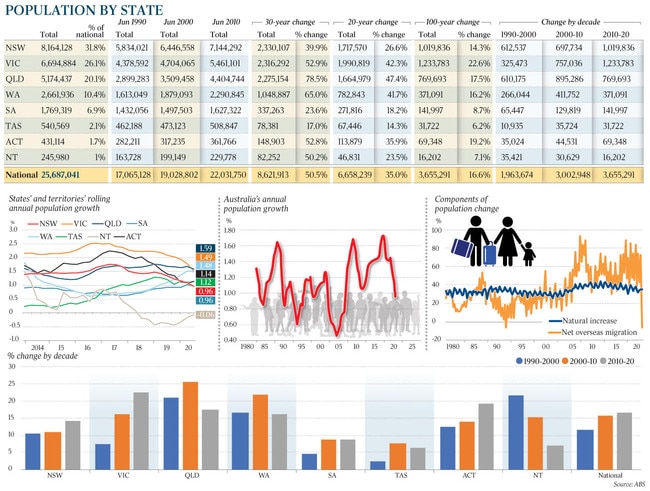People vote with feet for Queensland
Queensland now has the fastest growing population in the country, ending Victoria’s run of 6½ years.

Queensland now has the fastest growing population in the country, ending Victoria’s run of 6½ years.
As national population growth stalled because of COVID-19, NSW dropped below 1 per cent annual growth for the first time since September 2006 and is marginally behind South Australia.
The Sunshine State has the highest annual population growth rate of any state or territory for the first time since 2006, Australian Bureau of Statistics data reveals, adding 1.6 per cent to its total for the year ending June 30, 2020, pipping Victoria’s 1.5 per cent.
Overall, our population ground almost to a halt in the June quarter, rising just 0.1 per cent, the lowest since quarterly population estimates began in 1981.
The annual rise in population to June 2020 was 1.3 per cent, the lowest annual rate since December 2005, taking the overall population to 25,687,041 as at June 30.
The decline in the population growth rate was overwhelmingly due to a plunge in net overseas migration in the June 2020 quarter, the first quarter where the full impacts of the COVID-19 international travel restrictions were felt.
“Overseas migrant arrivals fell from … 158,400 in the March 2020 quarter to just 13,700 in the June 2020 quarter, a drop of 91 per cent,” the ABS report said.
Overseas migrant departures also dropped by 77 per cent.
“The net result … was the first negative net migration for Australia since the June quarter of 1993, and is of similar size (-5900 in June 2020 quarter, -6300 in June 1993 quarter).”
Adding to the population growth woes is the decade-long decline in Australia’s fertility rate, which sits at 1.65 births per woman.
Queensland’s population growth held up the best.
“Queensland gained the most people from net interstate migration (+6800) over the June 2020 quarter, while NSW lost the most (-4000),” the ABS report, Population and COVID-19, said.
“Victoria had the largest change in net migration, decreasing from +600 people in the previous quarter to -3000 in the June 2020 quarter.”
Retired Melbourne couple Jennie and Leo Lipp, 60 and 65, have made the big move north to the Gold Coast.
They bought their beachfront apartment overlooking Surfers Paradise’s Main Beach in April via an online auction, sight unseen.

The couple plan to spend six months a year between the two cities, gradually increasing their time on the Gold Coast as they get older.
“Growing up, my father loved the Gold Coast. He bought off-the-plan, before Surfers Paradise boomed,” Ms Lipp said.
“We have been trying for so long to get up here. Melbourne is so densely populated and hectic.”
“We just think the Coast is beautiful. It’s not like Italy where you have to pay for the beach to sit on pebbles,” Ms Lipp laughed.
The ABS data also confirmed the rapid ageing of Australia’s population over the past 20 years, with the median age (the age at which half the population is older and half is younger) increasing from 35 at June 30, 2000, to 38 at June 30, 2020.
“Tasmania had the largest increase in median age over the last 20 years, increasing from 37 years in 2000 to 42 years in 2020,” the report said.
The report also outlined the looming problem of fewer taxpayers having to support more Australians outside working age (15-64).
“Over the five years to 30 June, 2020, the working-age population grew by 6.1 per cent compared to 11.4 per cent for the remainder.
“The main contributor to the increased growth of the non-working-ages was the growth in the population aged 65 and over,” it said.



To join the conversation, please log in. Don't have an account? Register
Join the conversation, you are commenting as Logout